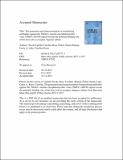The generation and characterisation of neutralising antibodies against the Theiler’s murine encephalomyelitis virus (TMEV) GDVII capsid reveals the potential binding site of the host cell co-receptor, heparan sulfate
Abstract
The early stages of picornavirus capsid assembly and the host factors involved are poorly understood. Since the localisation of viral proteins in infected cells can provide information on their function, antibodies against purified Theiler's murine encephalomyelitis virus (TMEV) GDVII capsids were generated by immunisation of rabbits. The resultant anti-TMEV capsid antibodies recognised a C-terminal region of VP1 but not VP2 or VP3 by Western analysis. Examination of the sites of TMEV capsid assembly by indirect immunofluorescence and confocal microscopy showed that at 5 h post infection, capsid signal was diffusely cytoplasmic with strong perinuclear staining and moved into large punctate structures from 6 to 8 h post infection. A plaque reduction neutralisation assay showed that the anti-TMEV capsid antibodies but not anti-VP1 antibodies could neutralise viral infection in vitro. The VP1 C-terminal residues recognised by the anti-TMEV capsid antibodies were mapped to a loop on the capsid surface near to the putative receptor binding pocket. In silico docking experiments showed that the known TMEV co-receptor, heparan sulfate, interacts with residues of VP1 in the putative receptor binding pocket, residues of VP3 in the adjacent pit and residues of the adjoining VP1 C-terminal loop which is recognised by the anti-TMEV capsid antibodies. These findings suggest that the anti-TMEV capsid antibodies neutralise virus infection by preventing heparan sulfate from binding to the capsid. The antibodies produced in this study are an important tool for further investigating virus-host cell interactions essential to picornavirus assembly.
Citation
Upfold , N , Ross , C , Bishop , Ö T , Luke , G A & Knox , C 2018 , ' The generation and characterisation of neutralising antibodies against the Theiler’s murine encephalomyelitis virus (TMEV) GDVII capsid reveals the potential binding site of the host cell co-receptor, heparan sulfate ' , Virus Research , vol. 244 , pp. 153-163 . https://doi.org/10.1016/j.virusres.2017.11.017
Publication
Virus Research
Status
Peer reviewed
ISSN
0168-1702Type
Journal article
Description
This work was supported by Medical Research Council (MRC, South Africa) and Research Council (RC, Rhodes University) grants. CR and ÖTB thank the National Research Foundation of South Africa (grant number 93690). NU was supported by postgraduate fellowships from the NRF and the German Academic Exchange Service (DAAD) and a Henderson Fellowship from Rhodes University.Collections
Items in the St Andrews Research Repository are protected by copyright, with all rights reserved, unless otherwise indicated.

